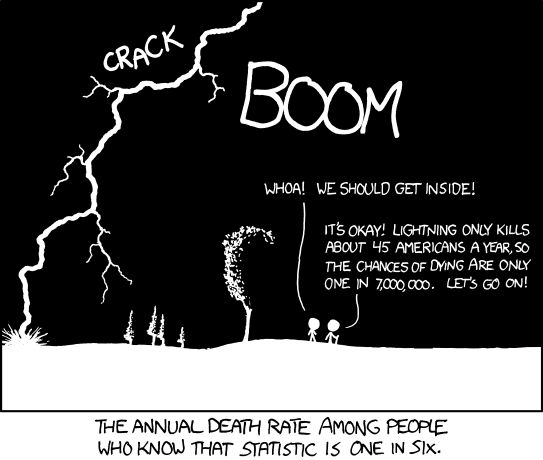How Are Sharks Less Dangerous than Vending Machines? An Exercise in Conditional Risk

(iStockphoto)
Did you know that vending machines, not a major danger in most of our minds, are twice as likely to kill you as a shark? I heard this statistic at the new shark-and-ray touch tank of the New England Aquarium, which I try to visit weekly with my daughters. You stand at a large, shallow tank with plexiglass walls and can lay your hand in the water, gently feeling the sharks and sting rays swimming by.
The aquarium probably wants to convince visitors that sharks are not the fierce predators of Jaws fame, and thereby help protect sharks from hunting and extinction. Although I could admire this motive, the comparison always surprised me. My number sense complained that sharks simply must be more dangerous than vending machines.
However, upon looking up the risks, I found that the comparison was correct. The yearly risk (in the United States) of dying from a shark attack is roughly 1 in 250 million. In contrast, the yearly risk of dying from a vending machine accident is roughly 1 in 112 million. The vending machine is indeed roughly twice as lethal as the shark!
Why then was I still troubled by the comparison? Maybe my number sense needed a tune up, and I should just accept the statistical facts of life. I then started thinking about it using the method of easy cases. This method, along with proportional reasoning (the tool in this post about colonial-era literacy), is one of my favorite tools for developing what I like to call number-sight: the ability to see connections among (and make sense of) the myriad numbers around us.
The easiest case is often an extreme one. My own extreme case of shark-attack risk happened while teaching at the African Institute for Mathematical Sciences, in Cape Town, South Africa. The institute is right on the beach, so one day I tried learning to surf (with more emphasis on “try” than on “learn”). I soon heard whistles from the lifeguards. Because the water was packed with swimmers, I assumed that swimmers were going too far out. That’s what the whistles meant on the New Jersey beaches in my childhood. As an adult who knew how to swim, why worry? After returning to shore, I learned that the whistle was warning everyone of a great white shark that had been sighted swimming around the bay. It was probably the same shark that had bitten the leg off a surfer a few months earlier.
Don’t tell me that, while surfing in that bay on that day, a vending machine posed more danger to me than that great white shark! From this extreme case, I realized the problem with the comparison. These statistics are averaged over everyone in the United States. In most places in the U.S., such as Kansas, people are nowhere near a body of water with sharks. The comparison of the risk to a vending machine, while true as far as it goes, ignores highly relevant information—such as whether one is swimming in the same bay as a shark.
The comparison also ignores important information about vending machines. After all, how do people die from a vending machine? Vending machines are not known carcinogens. I imagine that the machine takes someone’s money and malfunctions. The customer then shakes it to free the snack, whereupon the machine tips over and crushes the hot-tempered purchaser. As the doctors say, “Don’t do that then!” Keeping cool in this difficult situation probably reduces the vending-machine death risk to zero.
This problem of implicit but essential statistical information is wonderfully illustrated in this XKCD cartoon:

(used under XKCD’s license)

Comments